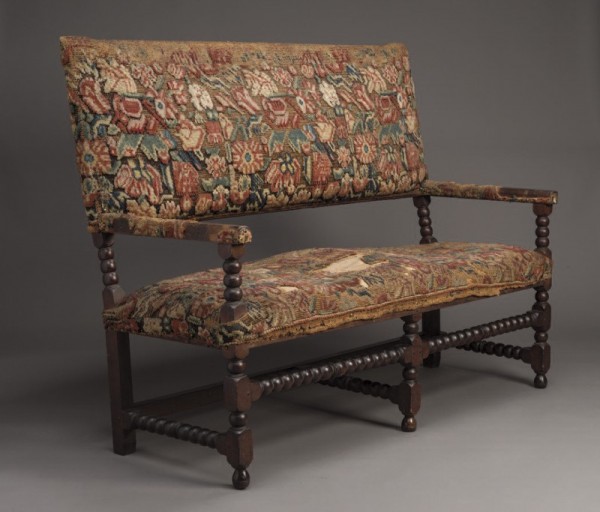
Couch, Boston, Massachusetts, ca. 1698. Maple and oak; original upholstery foundation and Turkey-work covers and trim. H. 46 5/8", W. 59 5/8", D. 27". (© 2017 Peabody Essex Museum, Salem, MA; photo, Bob Packert.)
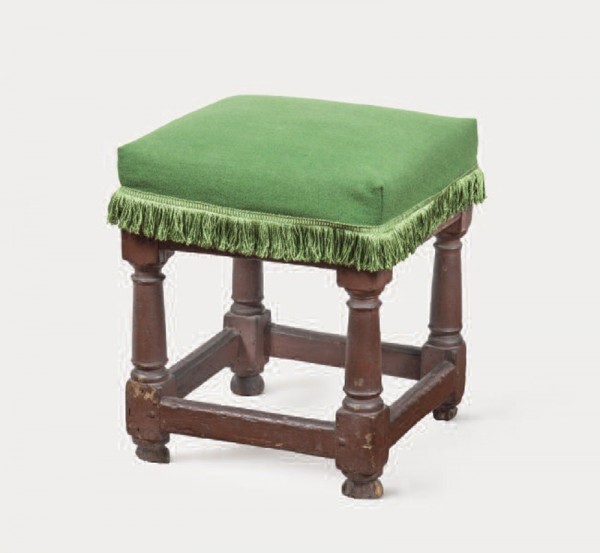
Stool, probably New Haven, Connecticut, 1640–1660. Oak. H. 14 1/2", W. 13 1/2", D. 14 1/2". (Courtesy, Wadsworth Atheneum, Wallace Nutting Collection, 1926.467; photo, Gavin Ashworth.) Andrew Passeri and Robert F. Trent fabricated the nonintrusive upholstery in 1984. Fragments of original webbing remain on the seat rails. It is possible that this frame originally had a down cushion sewn atop the webbing and sackcloth, like many of the objects with original upholstery at the historic house Knole in Kent.

Armchair, London, England, 1641–1655. Beech. H. 41 5/8", W. 25 13/16", D. at seat 18". (Pilgrim Society, bequest of Anna Nightingdale Warren Hobbs, 1957, PHM# 1175; photo, Andrew Davis.) Peter Arkell restored the lower part of the feet, seat rails, stay rail, and the forward portions of the grips in 1984, using the armchair illustrated in figure 4 as a guide. Manfred Woerner installed the current upholstery in 1986.

Armchair, London, England, 1640–1660. Beech; fragmentary silk velvet upholstery and painted decoration over gesso. Dimensions not recorded. (Courtesy, Winterthur Library, Joseph Downs Collection of Manuscripts and Printed Ephemera, R. W. Symonds Papers, collection 57, series 2, box 1, 59.436.) This image was taken before the armchair entered the collections of the Victoria and Albert Museum in London in 1953. The gesso under the painted decoration is visible in many areas of paint loss.
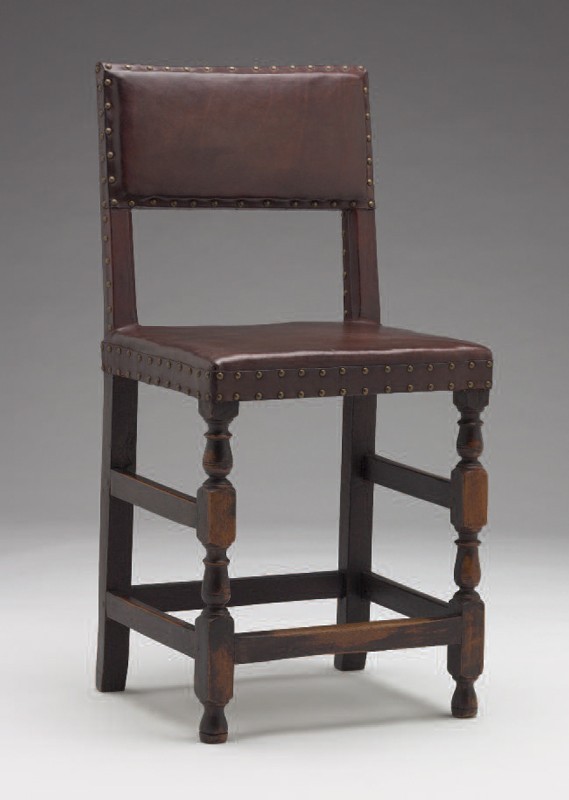
Side chair, possibly Boston, Massachusetts, 1660–1680. Maple and oak. H. 37 1/8", W. 18", D 15 3/16". (Yale University Art Gallery, gift of Mr. and Mrs. Frank J. Coyle, LL.B. 1943, 1991.178.1.) The present leather upholstery is modern.
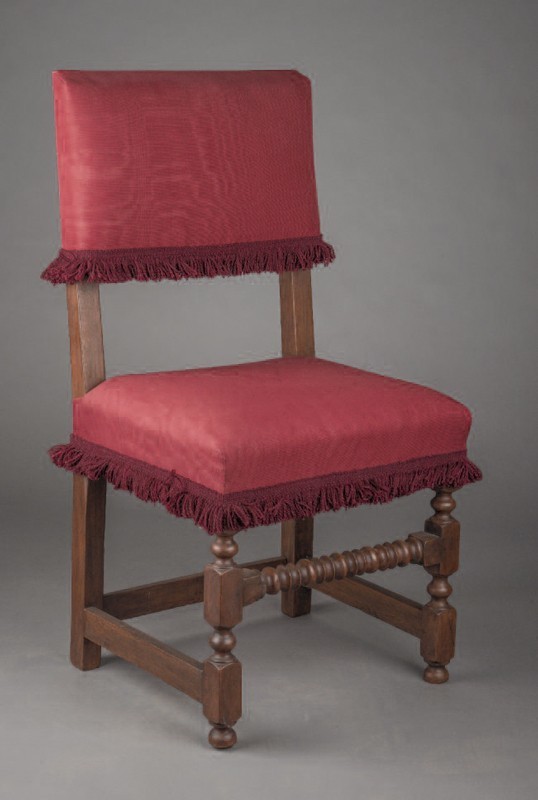
Side chair, probably Ipswich or Newbury, Massachusetts, 1670–1700. Maple and oak. H. 36", W. 18", D. 15 3/4". (Private collection; photo, Jim Wildeman.) Keith Lackman and Robert F. Trent fabricated the nonintrusive upholstery foundation and covers in 2005.

Side chair, New England or New York, 1670–1690. Maple. H. 37 5/8", W. 18 5/8", D. 19 3/4". (Metropolitan Museum of Art, gift of Mrs. Russell Sage, 1909, 10.125.203.) The left seat rail is a replacement, and the seat board is missing. The frame was upholstered later, perhaps in the eighteenth century. This example and two others from the Delaware Valley (Winterthur Museum; Philadelphia Museum of Art) are the only known American examples of this seating design.
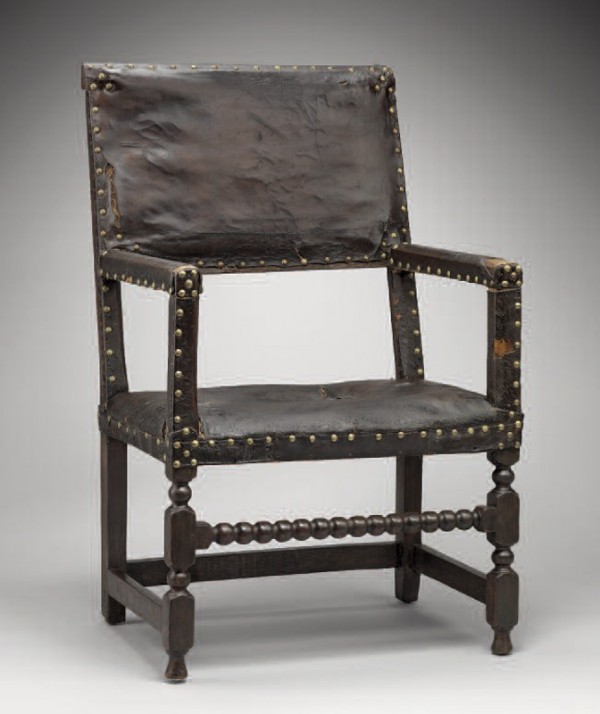
Armchair, attributed to the Symonds shop tradition, Salem, Massachusetts, 1675–1685. Maple and oak; with original upholstery foundation and leather covers. H. 38", W. 23 5/8", D. 16 3/8". (Courtesy, Museum of Fine Arts, Boston, Seth K. Sweetser Fund, 1977.711.) The Endicott armchair underwent conservation in 1977 and 1978; Vincent Cerbone did the finish work, and Andrew Passeri and Robert F. Trent conserved the upholstery foundation and covers. The brass nails are period replacements in the sites of the lost originals. The outside back was reinforced, and the original webbing and sackcloth were reattached in several places. One small section of the trim strip on the front seat rail and one corner of the back cover were in-filled with pieces of leather from the back cover of an early eighteenth-century Boston chair. Merville E. Nichols washed the leather with saddle soap and treated it with a lanolin mixture.
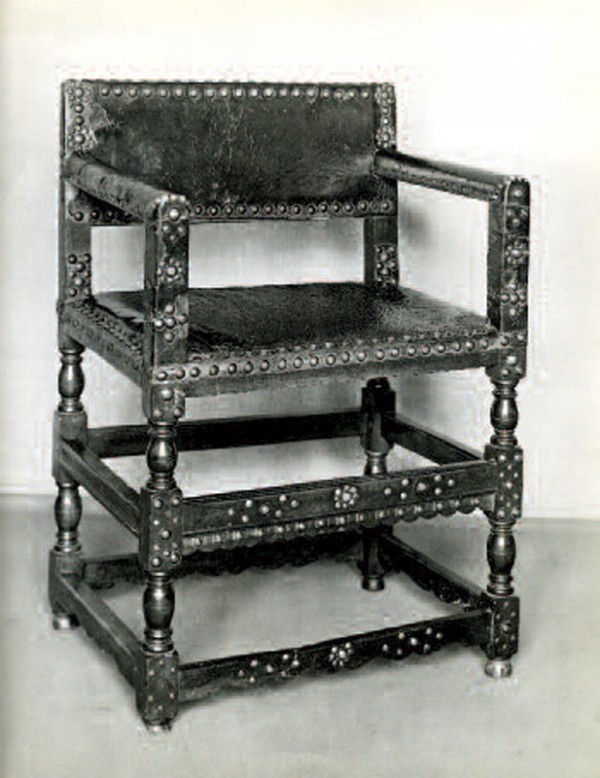
Armchair, Netherlands, ca. 1620. Probably walnut; original upholstery foundation, leather covers, and brass nailings. Dimensions not recorded. (Courtesy, Winterthur Library, Joseph Downs Collection of Manuscripts and Printed Ephemera, R. W. Symonds Papers, collection 57, series 2, box 1, 59.428.) The extravagant brass nailing on this chair is reminiscent of Iberian seating. All four posts have urn turnings, and the back has moderate layback. While it appears that the seat and back have little loft, the leather covers probably shrank and deflected the stuffing.
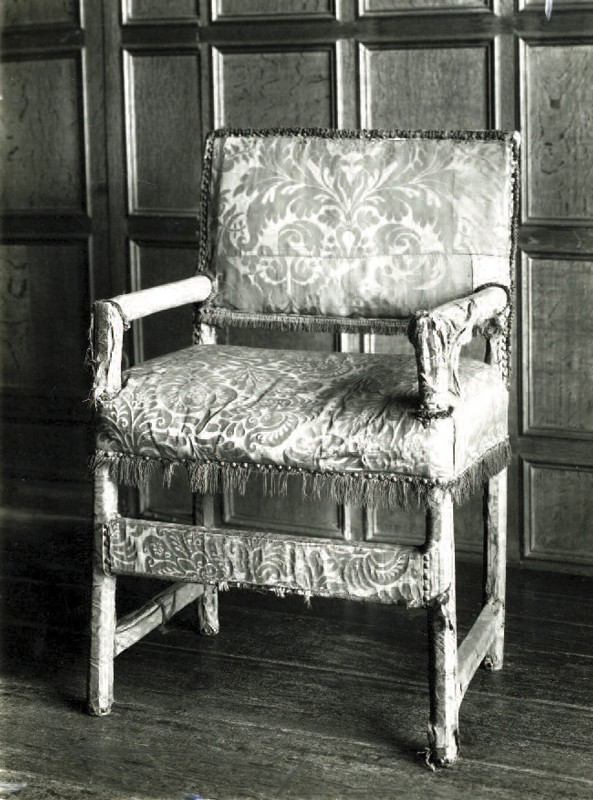
Armchair, possibly France, 1630–1670. Beech; silk damask. Dimensions not recorded. (Courtesy, Winterthur Library, Joseph Downs Collection of Manuscripts and Printed Ephemera, R. W. Symonds Papers, collection 57, series 2, box 1, 59.72.) This armchair is at Knole, Kent. The broad, flat front stretcher is common in sheathed chair frames. An extensive campaign to describe and conserve all the early upholstery at Knole is being conducted by conservator Heather Porter, Senior Conservator, Knole Conservation Studio, National Trust.
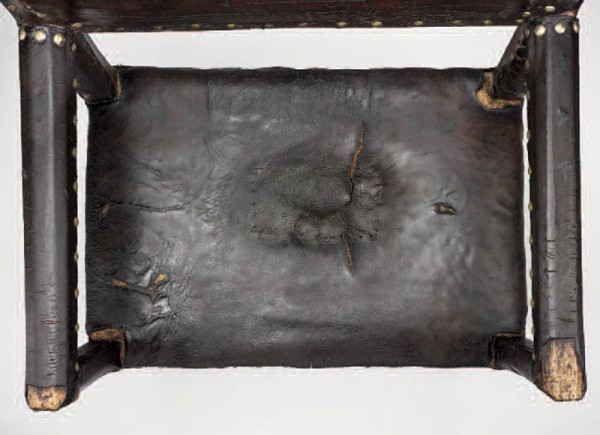
Detail of the armchair illustrated in figure 8, showing the stitching in the seat. Because the seat cover shrank drastically, the stitches appear to have snapped or to have been deliberately cut to prevent tearing.
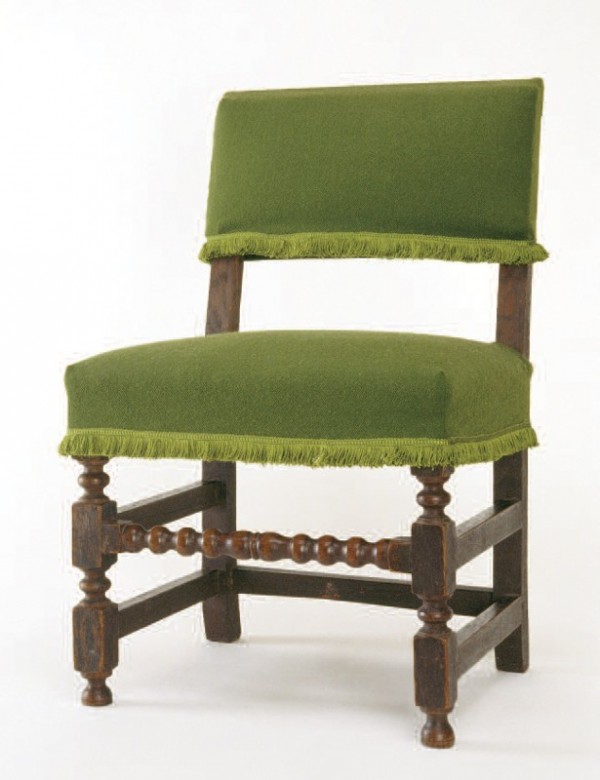
Side chair, probably Marlborough, Massachusetts, 1670–1700. Oak. H. 32 1/8", W. 18 3/4", D. 13 5/8". (Courtesy, Concord Museum, gift of Russell Kettell, F1094.) The chair retains the sackcloth and two webbing strips. One front post is replaced. Robert Walker, Andrew Passeri, and Robert F. Trent fabricated the nonintrusive upholstery panels and covers in 1984. There is no evidence of brass nailing, and the dimensions of the frame dictated the short fringe.

Side chair, Boston, Massachusetts, 1660–1700. Maple and oak. H. 35", W. 17 3/4", D. 17 3/4". (Collection of Anne H. and Frederick Vogel III; photo, Jim Schneck.) This frame has minimally intrusive upholstery with grass and horsehair stuffing and Russia leather covers from the cache of hides found in the 1786 shipwreck Metta Catherina in Plymouth harbor, England, in the 1970s. The discovery of the Russia leather hides is described in Geoff Garbett and Ian Skelton, The Wreck of the Metta Catherina (Truro: New Pages, 1987). The upholstery was executed by Mark Anderson.
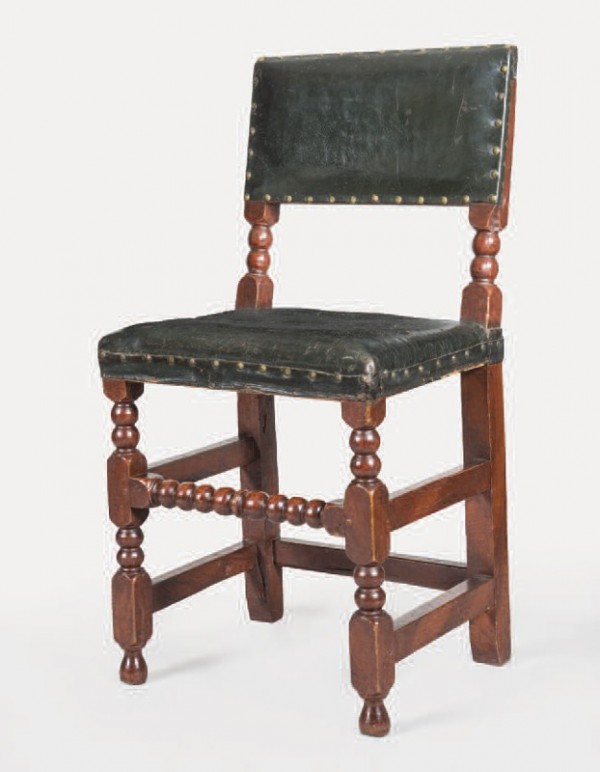
Side chair, Boston, Massachusetts, 1660–1700. Maple and oak; with original upholstery foundation and leather covers. H. 36", W. 18 1/8", D. 17 1/4". (Henry Francis du Pont Winterthur Museum, bequest of Henry Francis du Pont, 58.694; photo, Gavin Ashworth.) The original leather covers of this chair have a later coat of what appears to be a resin-based green preservative similar to those used on leather bindings by nineteenth-century librarians. Wadsworth Atheneum conservator Stephen Kornhauser removed similar coatings from chairs in that collection in 1984. At the same time that the green preservative was applied on this chair, a green painted piece of linen duck was added to cover the outside back.

Oval leaf table, Boston, Massachusetts, 1660–1700. Maple and oak. H. 27 1/4", W. (open) 48", D. 58". (Collection of Anne H. and Frederick Vogel III; photo, Jim Wildeman.) The top is a replacement.
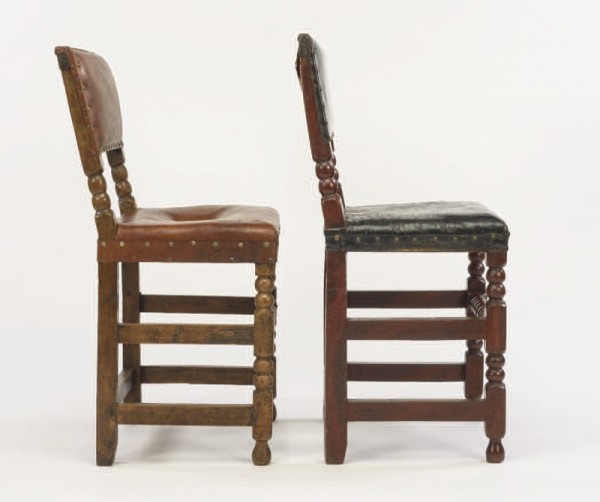
Side view of the chairs illustrated in figures 13 and 14, showing modern, minimally intrusive upholstery in eighteenth-century Russia leather on the left and original, shrunken calf leather covers and deflected upholstery on the right. (Photo, Jim Schneck.)
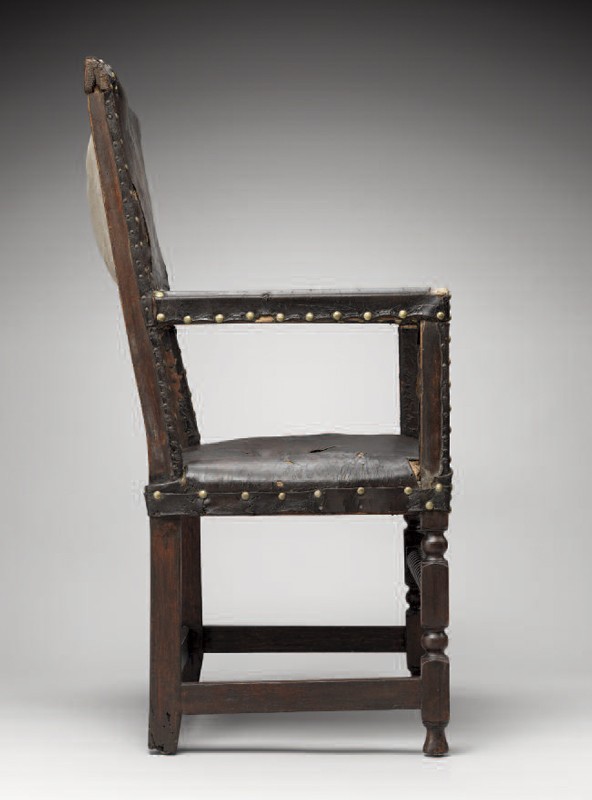
Side view of the armchair illustrated in figure 8, showing folded flags going around the posts on the seat leather and the shrunken arm sheathing retreated back from the brass nails.
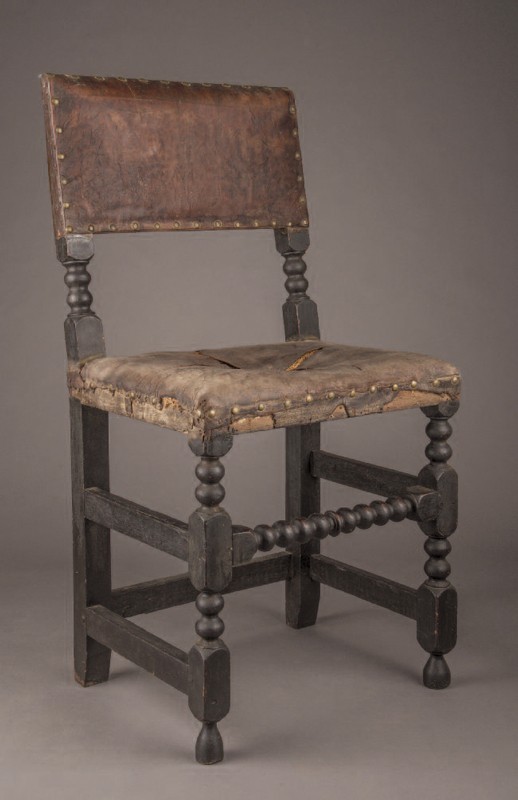
Side chair, Boston, Massachusetts, 1660–1700. Maple and oak; original leather cover and foundation upholstery. H. 37 3/4", W. 18 3/4", D. 15 1/2". (Private collection; photo, Jim Wildeman.) This chair was found recently in Newbury, Massachusetts. The stuffing and leather covers survived under many subsequent layers of covers. The black paint is probably nineteenth century and was applied with the later covers in place.
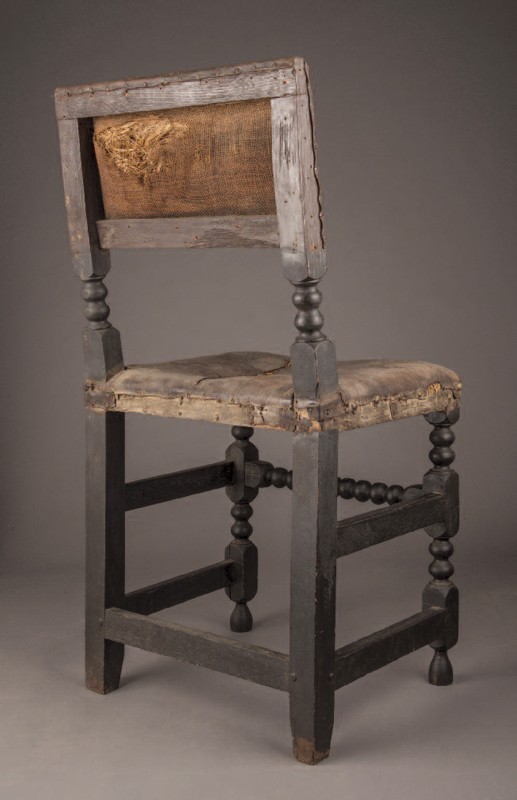
Rear view of the side chair illustrated in figure 18, showing the open outside back and back cover tacked to the side of the post.
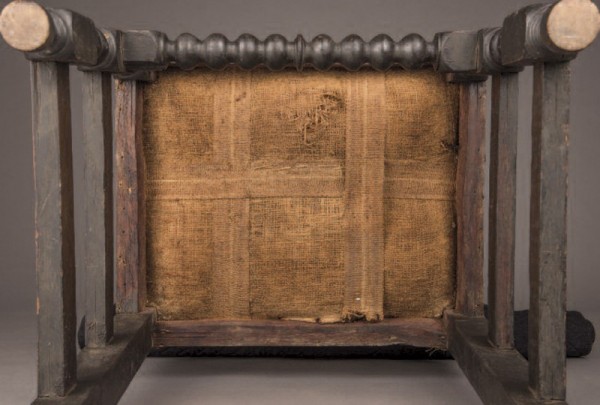
Detail of the side chair illustrated in figure 18, showing the webbing and sackcloth under the seat.
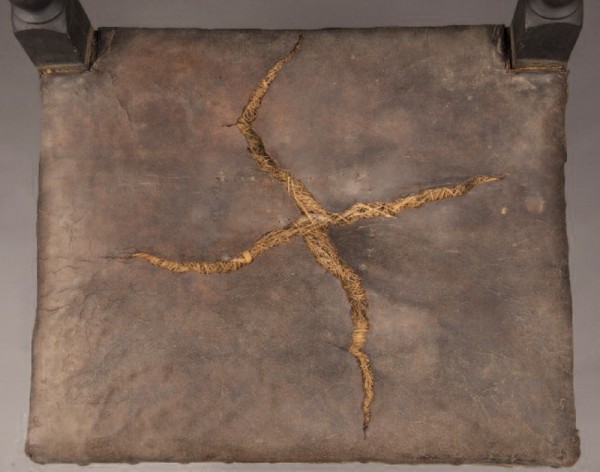
Detail of the side chair illustrated in figure 18, showing the stitching and torn leather cover on the seat.
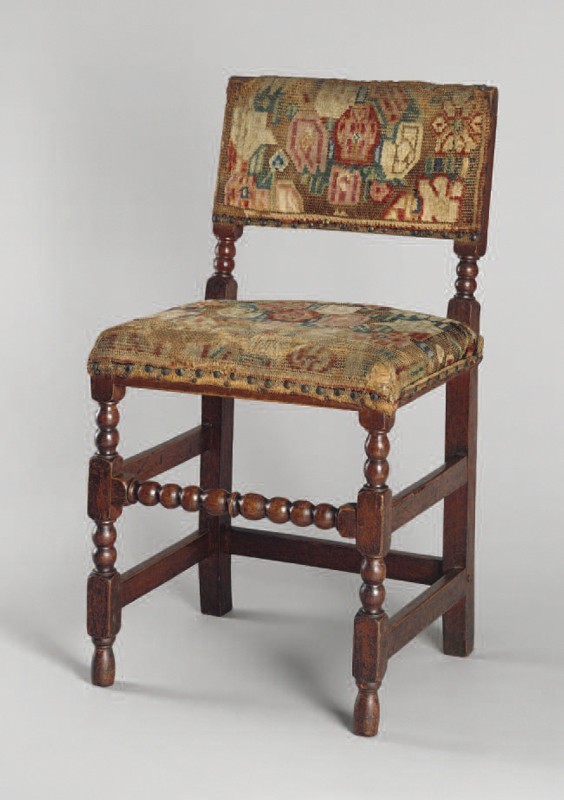
Side chair, Boston, Massachusetts, 1660–1700. Oak and maple; original Turkey- work covers, trim, and foundation upholstery. H. 37 1/8", W. 19 5/8", D. 19 7/8". (Courtesy, Metropolitan Museum of Art, bequest of Mrs. J. Insley Blair, 52.77.51; photo, Gavin Ashworth.) The webbing and sackcloth in the seat and the sackcloth in the back may be replaced. The upholstery retains extensive fragments of wool fringe and galloon held by brass nails. This is one of the few Boston Cromwellian chair frames with great heels.

Side chair, Boston Massachusetts, 1675–1700. Oak and maple; original Turkey-work covers, trim, and foundation upholstery. H. 40 3/4", W. 20", D. 20 3/4". (Courtesy, Metropolitan Museum of Art, bequest of Mrs. J. Insley Blair, 52.77.50; photo, Gavin Ashworth.) The upholstery retains extensive fragments of original fringe and galloon held by brass nails. The original webbing and sackcloth of the seat are supported by a modern prosthesis.

Detail of the couch illustrated in figure 1, showing the folded flag going around the left front post. (Photo, Bob Packert and Kathy Tarantola.)
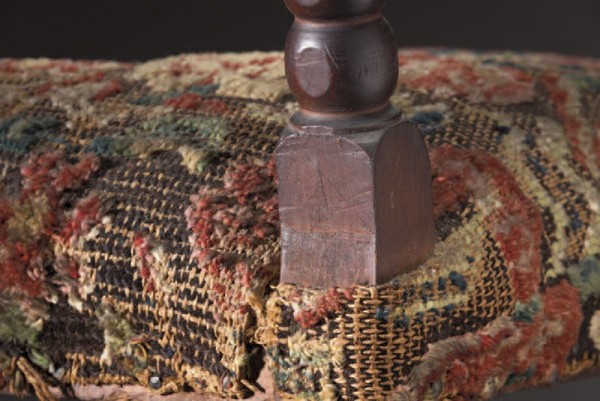
Detail of the couch illustrated in figure 1, showing the folded flag going around the left rear post, traces of red wash or stain, and the angle from sawing out the post blank, which was cleaned up with a flat chisel.
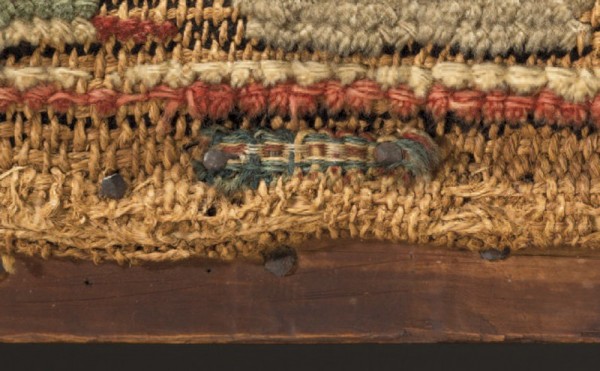
Detail of the couch illustrated in figure 1, showing a fragment of fringe heading held by two brass nails on the front seat rail.
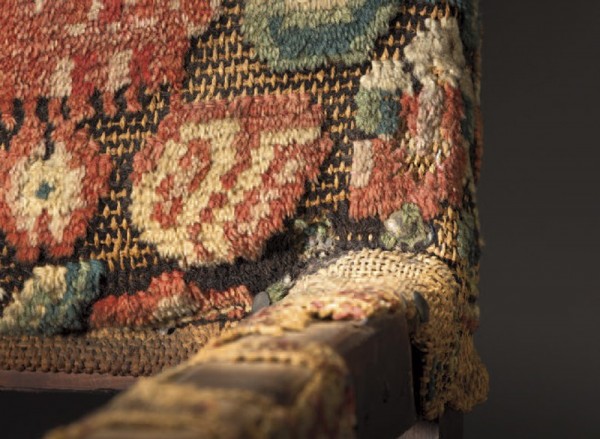
Detail of the couch illustrated in figure 1, showing a lacquered brass nail at the junction of the left arm and the rear post.
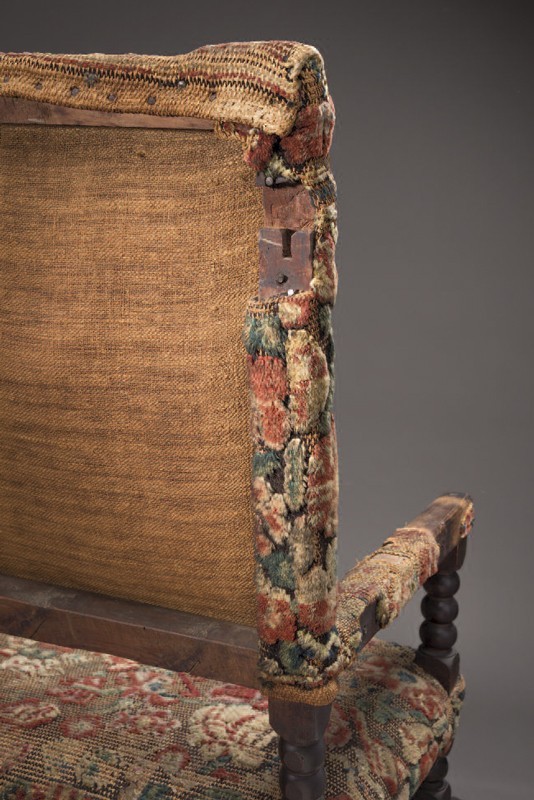
Detail of the couch illustrated in figure 1, showing the mortise for the keeper mechanism and the rolled covers brought around to the rear surface of the right rear post.
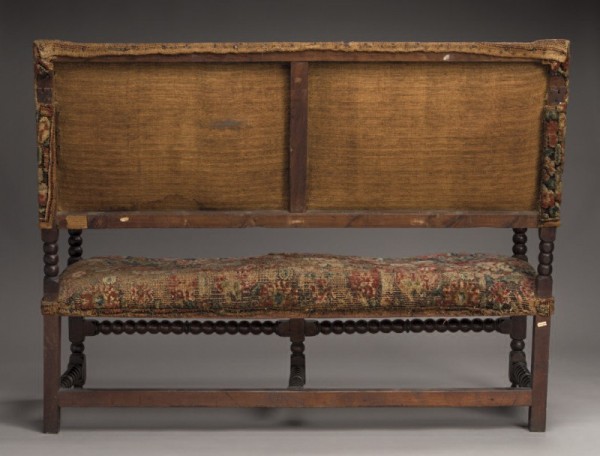
Rear view of the couch illustrated in figure 1.

Detail of the couch illustrated in figure 1, showing the underside of the seat with the webbing, sackcloth, and stitches for the front edge roll.
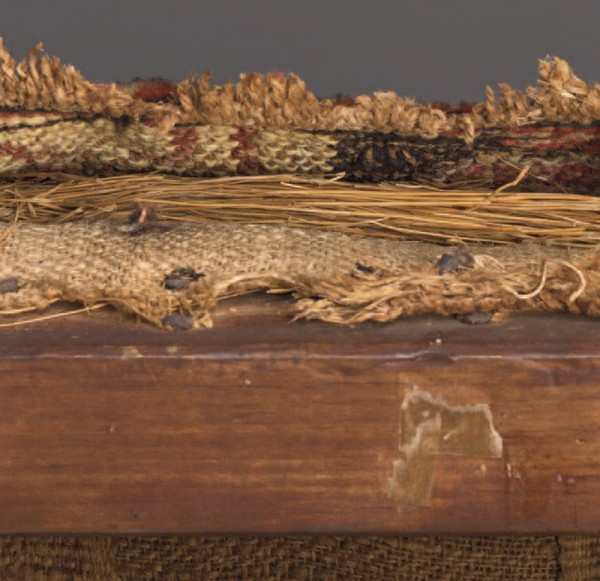
Detail of the couch illustrated in figure 1, showing the grass stuffing over the edge roll on the front seat rail.
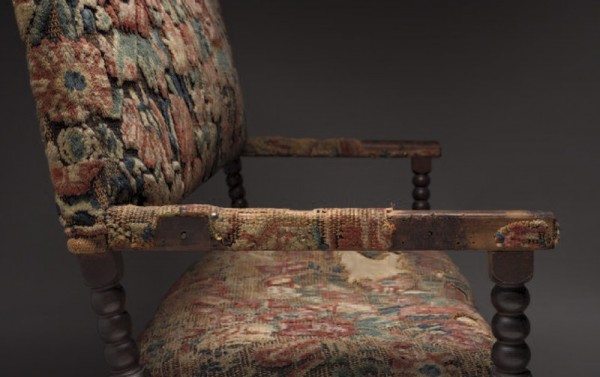
Detail of the couch illustrated in figure 1, showing the hinge sites on the end of the right arm.
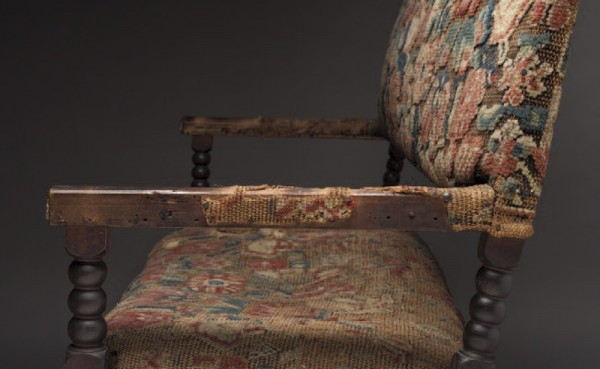
Detail of the couch illustrated in figure 1, showing the hinge sites on the end of the left arm.

Detail of the couch in figure 1, showing a rounded rivet head on the inside of the left arm.

Couch, Boston, Massachusetts, 1680–1700. Oak and maple. H. 42 1/8", W. 65 1/2", D. 29 1/8". (Henry Francis du Pont Winterthur Museum, bequest of Henry Francis du Pont, 58.698; photo, Jim Schneck.)
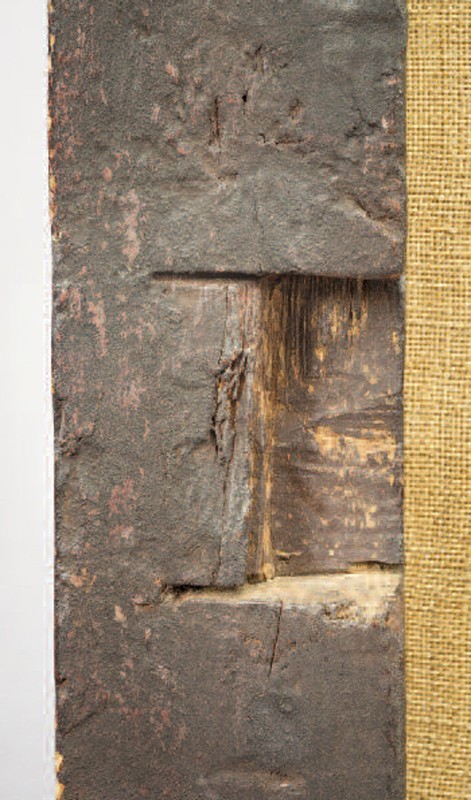
Detail of the couch illustrated in figure 35, showing the mortise and plugged rivet holes for an iron keeper on the rear surface of the right post. (Photo, Jim Schneck.)

Detail of the couch illustrated in figure 35, showing the rivet holes for hinges on the left arm.
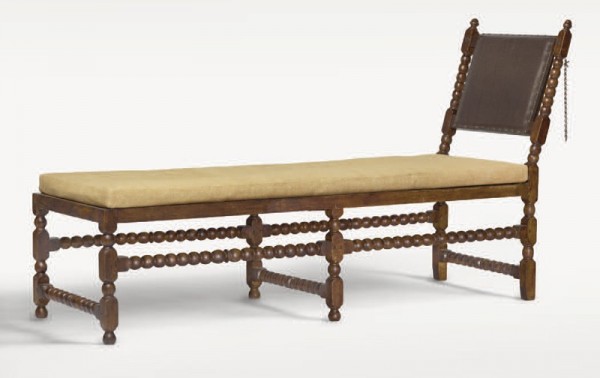
Couch, Boston, Massachusetts, 1690–1710. Maple. H. 37 1/2", W. 21 5/8", D. 67 3/8". (Collection of Anne H. and Frederick Vogel III for the Philadelphia Museum of Art; photo, Graydon Wood.) The swiveling back frame is replaced. Mark and Terry Anderson fabricated the leather upholstery of the back frame and the stitched hair seat mattress.

Side chair, New York City, 1660–1690. Oak; original upholstery foundation and leather covers. H. 37", W. 17 7/8", D. 16 1/4". (Courtesy, Pocumtuck Valley Memorial Association, gift of Joseph N. Fuller, 1880.47.1; photo, Gavin Ashworth.)
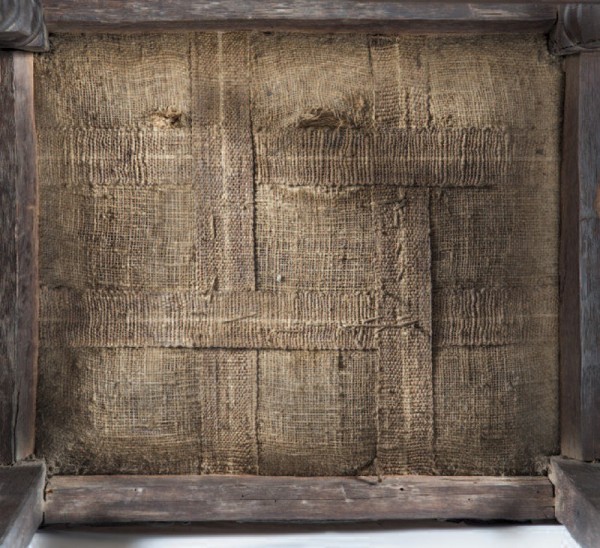
Detail of the chair in illustrated in figure 39, showing the webbing and sackcloth under the seat. (Photo, Gavin Ashworth.) The seat has four webbing strips placed near the center of the seat. The stitching of the seat passes through three of the webbing strips, but it is possible the upholsterer placed the stitched rectangle too far back. If he had placed it an inch forward, the stitches would have passed through all four webbing strips.
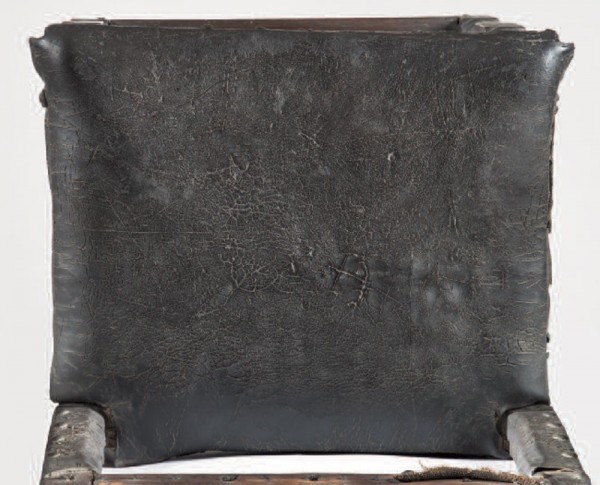
Detail of the chair illustrated in figure 39, showing the location of the stitches on the seat cover. (Photo, Gavin Ashworth.)
